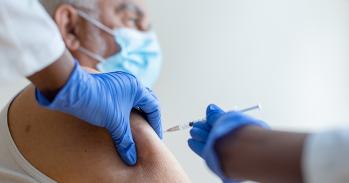The majority of patients who contracted COVID-19 while in hospital did so from other patients rather than from healthcare workers, concludes a new study from researchers at the University of Cambridge and Addenbrooke’s Hospital.
The majority of patients who contracted COVID-19 while in hospital did so from other patients rather than from healthcare workers, concludes a new study from researchers at the University of Cambridge and Addenbrooke’s Hospital.
The fact that the vast majority of infections were between patients suggests that measures taken by hospital staff to prevent staff transmitting the virus to patients, such as the wearing of masks, were likely to have been effective
Chris Illingworth
The study provides previously unprecedented detail on how infections might spread in a hospital context, showing that a minority of individuals can cause most of the transmission.
The researchers analysed data from the first wave of the pandemic, between March and June 2020. While a great deal of effort is made to prevent the spread of viruses within hospital by keeping infected and non-infected individuals apart, this task is made more difficult during times when the number of infections is high. The high level of transmissibility of the virus and the potential for infected individuals to be asymptomatic both make this task particularly challenging.
Looking back at data from the first wave, researchers identified five wards at Addenbrooke’s Hospital, part of Cambridge University Hospitals (CUH) NHS Foundation Trust, where multiple individuals, including patients and healthcare workers, tested positive for COVID-19 within a short space of time, suggesting that a local outbreak might have occurred.
Using new statistical methods that combine viral genome sequence data with clinical information about the locations of individuals, the researchers identified cases where the data were consistent with transmission occurring between individuals in the hospital. Looking in detail at these transmission events highlighted patterns in the data.
The results of the study, published today in eLife, showed that patients who were infected in the hospital were mostly infected by other patients, rather than by hospital staff. Out of 22 cases where patients were infected in hospital, 20 of these were the result of the virus spreading from patients to other patients
Dr Chris Illingworth, a lead author on the study, who carried out his research while at Cambridge’s MRC Biostatistics Unit, said: “The fact that the vast majority of infections were between patients suggests that measures taken by hospital staff to prevent staff transmitting the virus to patients, such as the wearing of masks, were likely to have been effective.
“But it also highlights why it is important that patients themselves are screened for COVID-19 regularly, even if asymptomatic, and wear face masks where possible.”
The study found contrasting results among healthcare workers, who were almost as likely to be infected by patients as they were by other healthcare workers. This was one piece of evidence that motivated the decision to upgrade the respiratory protection worn by healthcare workers in COVID-19 wards at CUH. A recent Cambridge study indicated that this resulted in staff being better protected against catching COVID-19.
The researchers also found a trend towards individuals either infecting no one else, or infecting multiple other people – just over a fifth of patients (21%) caused 80% of the infections. This phenomenon is sometimes called ‘superspreading’ and can make infection control very challenging. Whether or not an individual can be identified in advance as being more or less likely to pass on the virus is an ongoing topic of research.
Dr William Hamilton, an infectious diseases clinician at CUH and co-lead author on the study said: “Preventing new cases of hospital-based infection is a critical part of our work. Here we have shown that analysing clinical and viral genome sequence data can produce insights that inform infection control measures, which are so important for protecting patients and healthcare workers alike.”
The research was funded by COG-UK, Wellcome, the Academy of Medical Sciences, the Health Foundation and the NIHR Cambridge Biomedical Research Centre.
Reference
Illingworth, CJR & Hamilton, WL et al. Superspreaders drive the largest outbreaks of hospital onset COVID-19 infections. eLife; 24 Aug 2021; DOI: 10.7554/eLife.67308

The text in this work is licensed under a Creative Commons Attribution 4.0 International License. Images, including our videos, are Copyright ©University of Cambridge and licensors/contributors as identified. All rights reserved. We make our image and video content available in a number of ways – as here, on our main website under its Terms and conditions, and on a range of channels including social media that permit your use and sharing of our content under their respective Terms.




